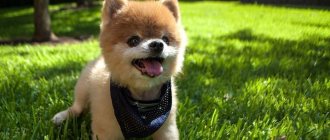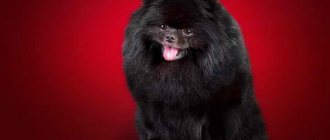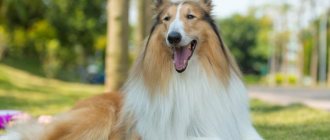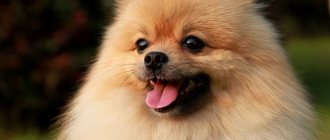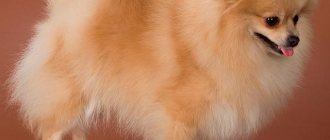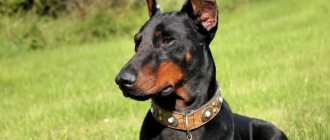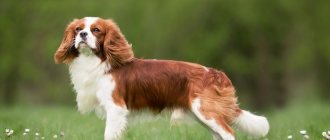The Pomeranian is a compact animal with long hair that makes it look like a plush toy. Many people consider the breed to be purely ornamental, but it was originally bred to hunt rodents. These are active and fearless animals, characterized by a complex temperament. Other names for the dog are Pomeranian, dwarf Spitz, miniature Spitz, etc.
The Pomeranian Spitz has long hair.
General characteristics of the breed
Pomeranians are suitable for private houses and apartments. They cannot be kept in an enclosure or on a chain near a kennel. Representatives of this breed have a complex character, so they are not recommended for novice dog breeders. With proper upbringing, the Miniature Spitz will become a good companion and protector for its owner.
The average life expectancy of an orange is 12-16 years. Thanks to its good mental abilities, the Miniature Spitz can quickly learn the preferences of its owner. The animal does not tolerate an indifferent attitude towards itself. It requires regular and careful care, long walks and active games.
Pros and cons of the breed
The advantages of the Pomeranian Spitz breeders include:
- good mental abilities and intelligence;
- courage;
- tendency to empathy;
- developed security and guard instincts;
- devotion;
- longer life expectancy;
- communication skills;
- possibility of apartment maintenance;
- decorativeness;
- compact sizes, etc.
Intelligence, loyalty, and courage are the advantages of the breed.
This breed also has many disadvantages. The main ones include:
- tendency to bark loudly;
- the complexity of socialization and education;
- increased excitability;
- severe shedding;
- fragile bones;
- need for careful care;
- tendency to wayward behavior, etc.
Walks
The harmonious development of the Pomeranian Spitz is impossible without regular time spent in the fresh air. An active orange is cramped in an apartment, and even in a house - only on the street can it fulfill its needs for movement and feel freedom of movement. Sunlight, air, and frost in winter have a beneficial effect on the formation of a puppy and the maintenance of good shape of an adult Pomeranian.
During walks, which the Pomeranian Spitz loves so much, it’s good to play with him, in the game he can consolidate or instill obedience skills, and lay the foundations for training.
They walk the puppies often, as soon as their feeding and sleeping schedule allows. At first, these forays are short and short-lived, but as they grow older they become longer and longer, expanding the horizons of knowledge. During walks, the animal learns to react correctly to surrounding noise, strangers and animals, and to overcome difficulties.
The history of the Pomeranian breed
The Pomeranian Spitz belongs to the group of ancient breeds. The remains of dogs similar to him were found in Switzerland, in the area of Lake Ladoga, as well as in Asia and Africa. The ancestors of the Zwegspitz were larger and reached a weight of 13 kg. The closest relatives of Pomeranians are considered to be strong Arctic dog species, incl. Chow Chows, Alaskan Malamutes and Huskies.
The ancestors of the Zwegspitz came to Western Europe along with traders. These animals were used to guard ships and property in ports. Gradually, the dog's ancestors decreased in size. They increasingly began to be kept in inns for hunting rodents. During the Middle Ages, interest in these animals increased, because... they were characterized by a beautiful appearance and energy. Residents of Germany were the first to notice the characteristics of the Miniature Spitz. The first attempts at selection were made here.
The Pomeranian is the oldest dog breed.
In the second half of the 18th century. Small dogs became in demand among rich people. This contributed to the spread of Spitz dogs. They were brought from Pomerania to England. Individuals of orange and sand color have become especially popular. Since 1980, breeding work has been carried out in this country. Breeders tried to get small individuals with long and thick hair. Attempts to improve the breed were successful, so the dogs began to often appear in the arms of ladies at various balls and official receptions. Even Queen Victoria had such a Pomeranian.
In 1892, these dogs were brought to the USA from English kennels. However, American cynological organizations for a long time did not recognize the Miniature Spitz as a separate breed. In this country, work on selection continued, which led to the appearance of animals with chocolate, white, spotted, red and other coat colors. At the beginning of the 20th century. Dog lovers founded their own Pomeranian Club of America. The breed has been recognized by other canine organizations.
The first exhibition was held in 1903. Then breeders focused their efforts on breeding dwarf Spitz dogs with persistent characteristics of color and coat density. Attempts to reduce the size of the breed were abandoned because... too small individuals were infertile, which made further breeding work difficult.
Exterior of the breed
The Miniature Spitz is a dwarf breed. The dog is characterized by a dense physique. She has developed muscles, but at the same time she is quite graceful and graceful. According to the FCI standard, the length of the animal must be equal to its height at the withers. Normally, it is 18-22 cm. The dog’s weight is 1.5-3.2 kg. Dogs weighing up to 2 kg are often shown at exhibitions.
Head
The head of the Dwarf Spitz is small. The back of the skull is quite wide, but towards the nose it narrows, forming a characteristic wedge. The forehead has a rounded shape. This part contrasts strongly with the occipital protuberance. Due to the plump cheeks, the cheekbones are almost invisible. The muzzle is narrow. The nose is small. It can be either black or brown.
The Spitz's head is small and its back is wide.
Ears
The ears are small and triangular in shape. Their tips are slightly pointed. Cartilage is quite tough. They are set close on the top of the head. At birth, the ears of the Dwarf Spitz are floppy. As they grow older, they “rise.”
Eyes
The animal's eyes look especially large against the background of its small head. The cornea is black. The eyes are slightly slanted. The shape can be either oval or almond-shaped. The eyelids are often black, but dark brown pigmentation is also possible. A healthy dog's eyes sparkle.
Teeth and jaws
The orange's jaw has a slightly elongated shape. The bite can be either straight or pincer-shaped. The animal has 42 teeth. In this case, the absence of premolars is not considered a defect. The upper jaw overlaps the lower jaw.
The Pomeranian Spitz has 42 teeth.
Body and neck
The neck is muscular and characterized by a slightly elongated shape. She is of medium length. There is no suspension. The high neckline is masked by lush fur. The back is short. The loin merges into a slightly sloping croup. The chest is well developed. According to the standard, the stomach should be toned.
Limbs
The forelimbs should be set wide apart. The shoulders are moderately muscular. The paws are small and neat. Fingers fit tightly. Pads are black or brown. The claws are often dark. The hind legs are parallel. The drumstick and thigh are approximately the same size.
Tail
The Spitz's tail is of medium length. He is set relatively high. The tail is curled into rings and often lies on the back.
Coat and color
The spinous cover is quite soft. A thick undercoat is hidden underneath. Dense fur is present on the body, paws, tail, muzzle and even ears. This breed is not characterized by the presence of wavy curls and waves. There is a mane with longer hair on the shoulders and neck of the Pomeranian.
The coat of dogs is soft, there are many types of colors.
The following colors are available:
- sable;
- cream;
- blue;
- white;
- black;
- orange;
- marble;
- black and tan;
- two-color;
- chocolate.
Disqualifying faults
Physical and mental defects considered grounds for disqualifying a dog from participation in breeding work and exhibitions include:
- apple-shaped head;
- strong narrowing of the black box;
- light color of the iris;
- flattened head shape;
- watery and overly bulging eyes;
- double ring on the tail;
- tittup;
- bodily pigmentation of the nose, eyelids and lips;
- excessively cowardly or aggressive behavior;
- half-drop ears;
- non-healed fontanel in an adult dog;
- malocclusion;
- inversion and eversion of the eyelids, etc.
Physical defects include watery eyes.
Character and behavioral characteristics
These animals perceive only one family member as the owner. There are often cases when a pet shows aggression towards other people living in the apartment. Pomeranians have good watchdog qualities and when a stranger appears on the doorstep of a house, they try to warn the owner with a loud bark.
The dog is small in size and weight, but cowardice is not characteristic of it. If the owner is in danger, the pet will rush to his defense. These animals are smart and easy to train. At the same time, the Miniature Spitz has a complex character and can try to take a dominant position. This pet is active and curious. He prefers outdoor games.
This dog is not suitable for people who want a pet that spends most of its time on the couch.
Pomeranian's attitude towards children and other pets
An adult dwarf Spitz may react negatively to the arrival of a child in the family. Being jealous will cause your pet to start showing aggression. It is recommended for families with children over 6 years old to have a pet. Miniature Spitz dogs are quite vindictive, so they can show aggression towards those who treat them rudely or cause pain. It is extremely important that the child understands that a pet is not a toy and requires careful handling. If a dwarf Spitz comes into contact with children from a young age, he will happily take part in joint games.
The attitude towards other animals depends on the individual characteristics of the psyche of the dwarf Spitz. Some dogs get along well with cats, parrots and even rats. Pet aggression especially often manifests itself if the owners pay too much attention to the animal that has just appeared in the house.
Sometimes Pomeranians show aggression towards people.
Ways to remove unpleasant dog odor from carpets
If your carpet smells like dog, you need to clean it. Dry cleaning or washing with a powder that has a strong smell will help remove the unpleasant dog odor. The following will also help remove dog odors from the carpet:
- daily struggle with wool getting stuck in the rug;
- cleaning with washing powder slurry;
- washing with dishwashing detergent.
Aromatic oil, which needs to be dripped all over the carpet, will mask the dog smell for a short time. It is also recommended to install an automatic air freshener for living rooms.
Education and training
Dwarf Spitz dogs are characterized not only by their developed intelligence, but also by their stubbornness, which makes training difficult. It is important that the owner is an authority for the dog, because... otherwise, the upbringing process will become more difficult. Training should begin after the animal reaches 3-4 weeks of age. The owner needs to be consistent and firm. It is necessary to gradually teach the animal new tricks. At the same time, you should treat your pet delicately and regularly reward it for correct behavior.
How to train a dog to use a litter tray or diaper
From a young age, Pomeranians are taught to relieve themselves in a litter box or on a diaper. Due to the long hair of animals, it is not always convenient to walk them outside in wet weather. The process of training a dog to use a litter box can take up to 2-3 months. At first, the puppy will relieve itself wherever necessary. Diapers should be placed in the places that the animal “likes” most. You can place a piece of rag soaked in puppy urine on top of them.
After a week, you should reduce the number of diapers. At the same time, you need to regularly wet clean the floors so that the smell does not remain on them. Over the next 2 weeks, gradually reduce the number of diapers until only one remains.
To accustom a Miniature Spitz to the litter box, the puppy must be brought as often as possible to a place where he is allowed to relieve himself.
If your dog urinates on walls and furniture, you should use antigadin spray or another product with a similar effect.
Main teams
Dog training should begin at a young age. First you need to learn the basic commands. At 1.5 months, the animal must master “fu”, “place” and “no”.
After mastering the basic commands, you can learn tricks.
At 8 weeks, the pet begins to be taught the “sit” and “come” commands. At 3 months, the dog should master “lying down.” Until the age of six months, the dwarf Spitz is gradually taught to perform the commands “stand”, “give”, “near”, “wait”, “voice”, “walk” and “fetch”. Once your dog has mastered the basics, you can start teaching him tricks. However, the animal should not be overloaded.
Contents of the Pomeranian Spitz
The dwarf Spitz is a full-fledged dog that requires the creation of favorable conditions for it. You need to buy a tray with low boots. The filler should be changed regularly. If diapers will be used, they should also be checked frequently for cleanliness.
In addition, it is necessary to arrange a sleeping place for the dog. You can use a soft bed made of natural materials or install a special booth. Pomeranians are active, playful and inquisitive, so you should buy toys for your pet in advance.
Water and food bowls should be appropriate for the size of the dog. If the sides are too high, it will create discomfort for the animal.
Miniature Spitz care
The Miniature Spitz requires special care. His eyes should be checked regularly and any discharge removed if necessary. In addition, you should periodically inspect your ears and clean them with a slightly moistened cotton swab. It is recommended to shorten the nails approximately once every few months. To do this, use a special nail clipper for dwarf breeds. The remaining edges must be filed. Your pet's teeth should be cleaned of plaque 2-3 times a week. In addition, it is advisable to give the animal special hard bones to remove tartar.
Pomeranians need to be brushed regularly.
Particular attention should be paid to wool. From the first week of life, the puppy is accustomed to daily brushing. This is extremely important because... The dog's fur is quite soft and easily rolls into balls. It is worth using special brushes that are not capable of injuring the delicate skin of the animal. The coat should be combed with slightly damp hair. Before the procedure, you need to fill a container with a spray bottle with warm water mixed with conditioner.
Dwarf Spitz dogs are bathed as needed, but it is not advisable to carry out water procedures more than 2 times a month. In this case, you should use only diluted shampoo for long-haired breeds, because... concentrated product may harm the skin. After bathing, the orange's coat must be combed and then dried with a hairdryer. Grooming procedures should be performed periodically.
At the same time, it is not recommended to cut the wool too short, because... this will slow down its growth.
Choosing clothes for a dog
The Miniature Schnauzer is characterized by good heat regulation and has a thick, warm undercoat, so the pet does not require additional protection from the cold. Clothing is purchased for the animal to prevent the fur from getting wet. You should only dress up your pet if absolutely necessary, because... the fabric may damage the wool.
When choosing clothes for your dog, you should pay attention to the seams. They shouldn't be too rough. Good clothing does not restrict the animal's movement. It is important that the decorative elements do not cling to the wool. You need to make sure that the clothes were made from natural materials.
How to properly clean wood floors from dog urine
While the most unpleasant formations can be removed from the carpet quite quickly, the pungent dog “aroma” from a wooden floor is a dangerous problem. The appearance of dampness (if the dog peed in the same place several times) can lead to damage to the varnish and swelling of the laminate or parquet. Initially, dog urine is removed using a napkin or towel. You need to blot the puddle, wash the floor with clean water, and wipe dry. Next you can do the following:
- rub the laminate with lemon peel;
- make a paste of soda and water (change when dry);
- neutralize the stench by washing the flooring with a floor cleaner that smells of lavender and mint.
The use of ordinary bleach or powder is unacceptable: they will not help remove dog urine from the floor and will damage the coating (suitable only for light-colored linoleum). To prevent your dog from peeing on the floor again and the room smelling like urine, you can try a weaning spray. True, it rarely helps. If the dog begins to go to the toilet in the room due to old age, you will have to lay oilcloths or a medical diaper on the floor. Difficulties are also possible when an adult dog marks the territory due to the appearance of a cat.
Feeding your orange
Poor quality nutrition can lead not only to deterioration of the coat condition, but also to health problems for the pet.
Feeding your Pomeranian affects the condition of its coat.
This active animal requires a balanced diet. You can use premium dry food. At the same time, you can also give natural products. Food should be high in calories and rich in beneficial compounds. The basis of the diet is lean meat and fish. In addition, you can give your animal:
- chicken and salmon fat;
- spinach;
- green beans;
- peas;
- bell pepper;
- carrot;
- zucchini;
- oatmeal;
- rice porridge;
- potato;
- quinoa;
- boiled eggs;
- plain yogurt;
- low-fat cottage cheese.
In addition, small quantities of fruit can be given to your dwarf Spitz.
At the same time, you should not feed your dog smoked meats, sweets, spicy dishes and flour products. In addition, it is not recommended to give your Miniature Spitz whole milk.
People's opinion
People love all Spitz breeds, each in their own way. Anyone who has already acquired a representative of one of the above species believes that his pet is the best. Indeed, the external characteristics of such dogs are simply magnificent. All Spitz look like little bear cubs.
If we remember such a disadvantage as excessive “talkativeness,” then the owners confirm it. After all, Spitz love to “talk” or bark at someone. But even this does not reduce the love of owners for their pets.
Pomeranian Spitz Health
Pomeranians inherited good health from their ancestors. To protect the animal from infections, it is necessary to carry out vaccinations in a timely manner.
To stay healthy, you need to visit a veterinarian.
Colostral immunity weakens in puppies at 9 weeks. Vaccinations are given according to the schedule at 9 and 11 weeks, and then at 6 and 12 months. The vaccine is administered only to healthy dogs. 2 weeks before vaccination, anthelmintic measures should be taken. Common diseases of Pomeranians include:
- colitis;
- dysbacteriosis;
- atlantoaxial joint dislocation;
- hypothyroidism;
- cryptorchidism;
- tracheal collapse;
- medial luxation of the patella;
- tearfulness;
- hydrocephalus;
- cataract;
- spasm of the larynx;
- ligament weakness.
Marbled Pomeranians are often born with increased intraocular pressure and deafness.
In addition, there are frequent cases of puppies being born with severe pathologies of the musculoskeletal system, as well as the nervous or cardiovascular system.
Some important rules
Rules to follow:
- It is very useful to brush your Spitz's coat before bathing. This will allow you to achieve better washing results.
- The bottom of the bath is covered with a rubber or silicone mat to prevent paws from slipping and causing panic. The dog must stand steadily.
- It is advisable to carry out the first baths together: one owner holds and calms the dog, the second wets the fur and distributes shampoo, and receives the animal in a towel. This makes it possible to streamline the procedure and gradually teach the Pomeranian to tolerate it calmly.
- After wetting the wool, the detergent is applied from top to bottom, without circular soaping, gently massaging the coat. When choosing a shampoo, pay attention to the content of unnatural substances; preference is given to hypoallergenic formulations.
- The head is washed last, avoiding getting water into the ears and shampoo into the eyes. A damp atmosphere in the bathroom and without targeted washing will soften dried dirt in the ears and eyes; they can be easily removed with a cotton pad and pad.
- Do not wipe wet Spitz fur with a towel, but only blot it. You can change the towel and repeat the removal of moisture.
- It is not necessary to use a hairdryer in a warm, dry and clean room. Wool dries quickly naturally. If the temperature in the house is unstable, it is recommended to use a directed, non-hot and gentle stream of air (from bottom to top, from the stomach to the back).
Bathing softens dried dirt, eliminates odors, and unclogs skin pores. Pomeranians usually feel very good after a properly performed procedure.
Breeding Miniature Spitz
Bitches of this breed begin to go into heat at about one year of age, but breeding cannot be done right away. Only after the dog reaches 2 years old can you plan to have offspring. Males are bred at 18 months. Bitches come into heat twice a year and last up to 22 days. Before mating, it is imperative to show the animals to a veterinarian.
Dogs are bred after they reach two years of age.
If the bitch is sick, weakened or has signs of obesity, it is better to wait a little while getting offspring. The gestation period for this breed is 63 days. If labor begins on day 57 or earlier, there is a high probability of stillbirth. There can be from 1 to 3 puppies in a litter. During pregnancy, the bitch must be protected from jumping from high heights, hypothermia, blows, etc. In addition, she requires high-quality nutrition.
Due to the small size of Pomeranians, childbirth often occurs with complications. The owner of a bitch needs to be prepared for the fact that the dog will need to be urgently taken to the clinic for a cesarean section. Severe complications occur especially often during the first birth. It is advisable to let the bitch eat the afterbirth, because... this will help normalize her condition and increase her immunity.
The muzzles of newborn puppies should be freed from the amniotic sac. They need to be held upside down so that fluid comes out of the respiratory tract.
How to choose a puppy
First, the future owner should decide whether the dog will just be a pet or whether it is desirable for it to participate in exhibitions and breeding work in the future. Its price will depend on the degree to which the animal meets the standards. It is better to buy a puppy from a kennel or from a breeder with a good reputation. The pedigree of the parents should be studied, paying special attention to their health.
It is worth buying a puppy that has reached the age of 3 months. He must already have a passport and the necessary vaccinations. You should definitely pay attention to the behavior of the animal. The puppy should be active and not afraid of strangers. At this age, Pomeranians begin to shed, so small bald patches are considered normal.
Owner reviews
Tatyana, 25 years old : “The dog is very smart. Our Rocky knows the basic commands. I didn’t give in to training right away, it takes time and patience.”
Irina, 33 years old : “The only negative is the constant yapping. And our Bonya is very affectionate, devoted and understanding.”
Oleg, 37 years old : “A hyperactive dog that requires a lot of attention. I gave it to my children and I don’t regret it: they get along great and play together.”
The main components of the health and long life of the orange are a balanced diet, care and exercise. Providing all this is not so difficult, but it takes a lot of time.



